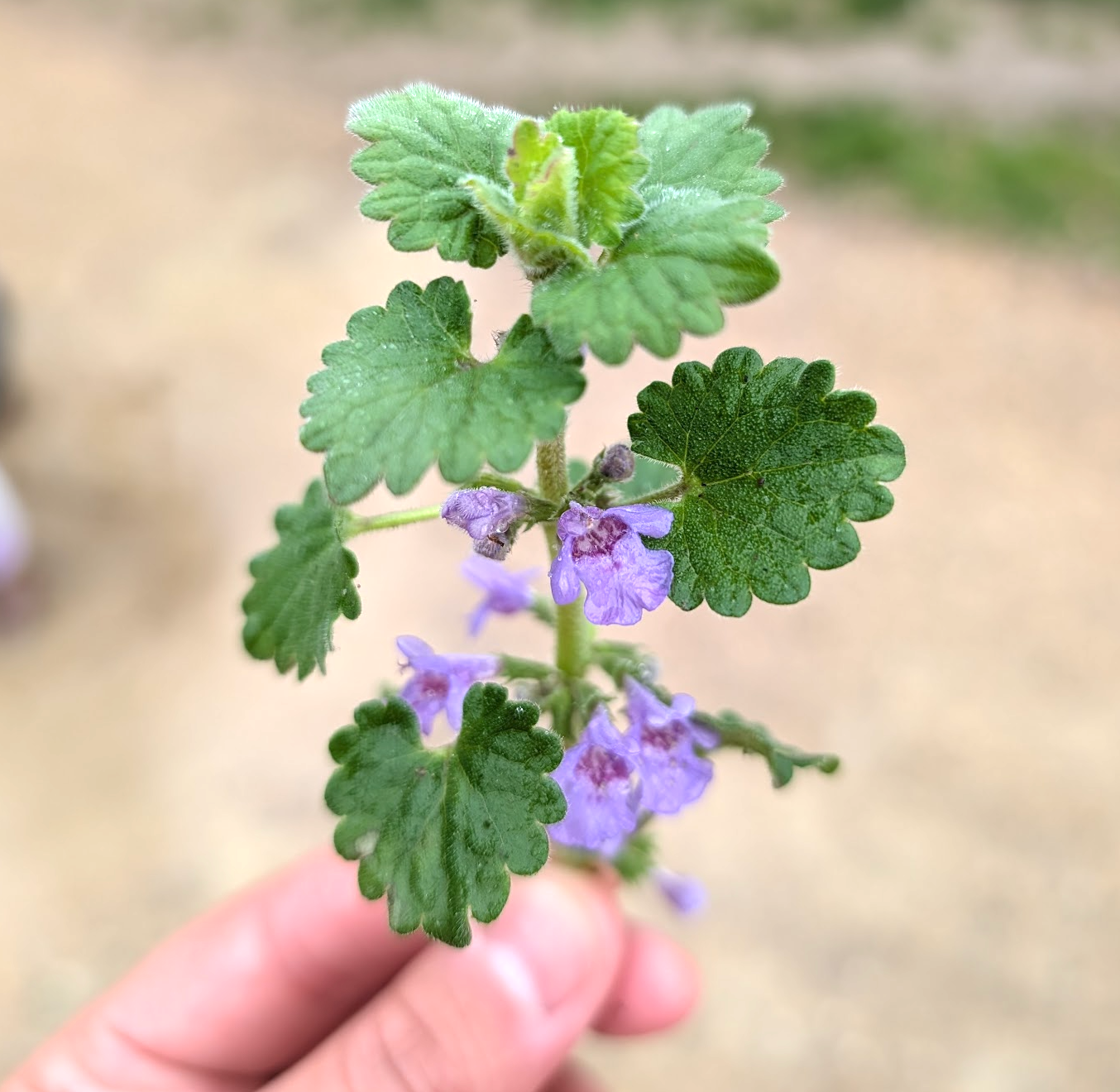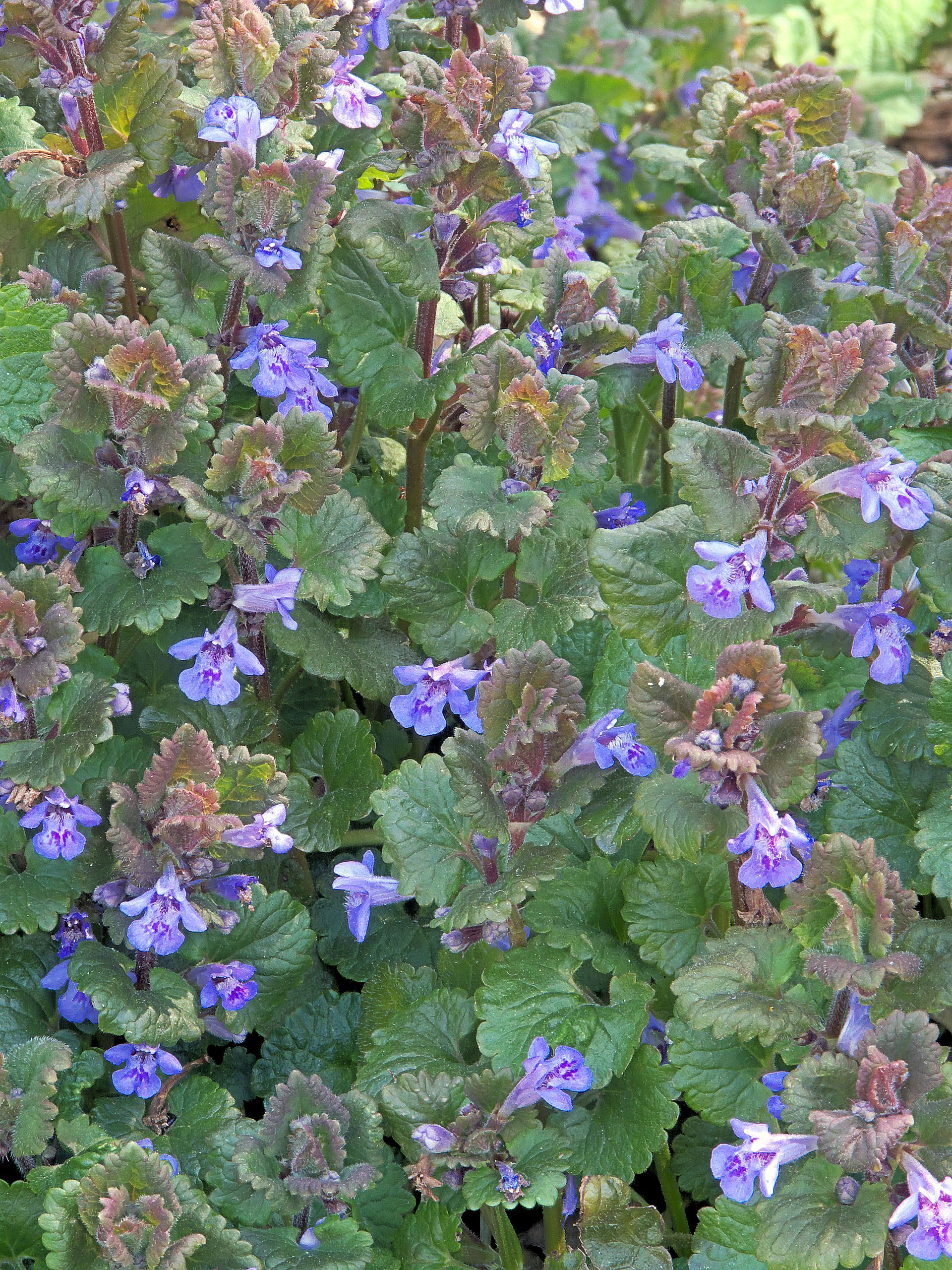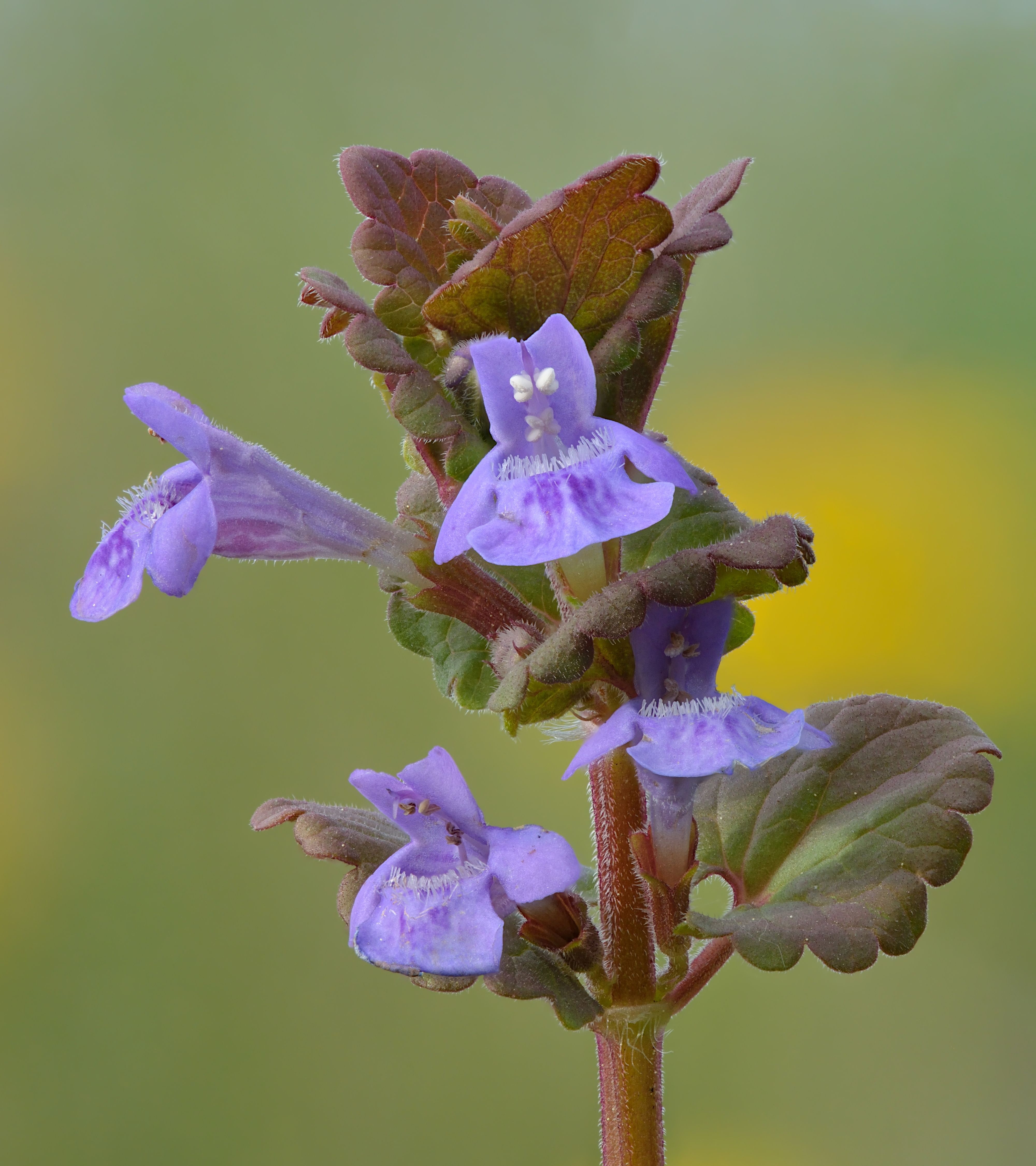

Nature identification courses
Effortlessly learn to recognise the species that grow around you, and remember what you learn forever... guaranteed!
Ground Ivy - Glechoma hederacea identification and ultimate guide
Introduction
Ground-ivy (Glechoma hederacea), also known as creeping Charlie or Gill-over-the-ground, is a common perennial wildflower native throughout Britain and much of Europe and Asia. Easily identified by its creeping habit and delicate violet flowers, it thrives in woodlands, gardens, and grasslands. It is a member of the mint family (Lamiaceae) and shares that family's distinctive aromatic qualities.
Quick Facts
- Common Name: Ground-ivy, Creeping Charlie, Alehoof, Gill-over-the-ground
- Scientific Name: Glechoma hederacea
- Family: Lamiaceae (Mint family)
- Habitat: Woodlands, hedgerows, gardens
- Bloom Time: March to June
- Native Status: Native to the UK and most of Europe
- Conservation Status: Common, no concern
Interesting Tidbits
- Ground-ivy was historically used in brewing beer before the adoption of hops, valued both for its preservative qualities and flavour.
- The plant emits a minty aroma when crushed, a hallmark of the mint family, and was once strewn on floors to freshen air indoors.
- Its Latin name "hederacea" means "ivy-like", referencing its creeping, ground-hugging habit.
- In medieval Britain, it was sometimes used to clarify beer—a property referred to as "fining"—which helped remove suspended proteins.
- Despite its name, Ground-ivy is not closely related to true ivy (Hedera helix).
Ecological Importance & Conservation
Ground-ivy plays a valuable role in supporting early-season pollinators. Its flowers appear in early spring when nectar sources are scarce, offering a vital food source for bumblebees, solitary bees, and even some hoverflies. The plant also provides ground cover that stabilises soil, helping to prevent erosion in woodland margins and garden beds. Its dense mats offer microhabitats for insects and other invertebrates.
Although not considered threatened in the UK or Europe, its ecological benefits are gaining recognition among conservation gardeners and rewilding advocates. By encouraging its growth in suitable, controlled areas, gardeners can help promote pollinator diversity and build resilient planting schemes. However, it should be managed with care, as it can become invasive in some settings.
Overview & Identification
Ground-ivy is a creeping, evergreen perennial plant with square stems and rounded, kidney-shaped leaves. Its flowers are small, funnel-shaped, and typically violet or bluish-purple, growing in whorls in the leaf axils. The plant spreads by stolons (horizontal stems) that root at nodes, forming dense carpets on the forest floor or garden bed.

Botanical Description & Life Cycle
Ground-ivy is a stoloniferous perennial with square, hairy stems typical of the mint family. Leaves are opposite, crenate (scalloped-edged), and dark green with a slightly purple tint in colder months. Flowers are bilabiate (two-lipped), with a distinctive lower lip marked with dark purple lines that guide pollinators. Flowering typically occurs from March to June. After flowering, the plant produces nutlets for seed dispersal, although it spreads more effectively via vegetative means.

A dense bed of Ground Ivy
History & Cultural Significance
Ground-ivy has been used for centuries in both domestic and medicinal contexts. In medieval Britain, it was commonly used in brewing before hops became the standard. The plant was called "alehoof," referencing its role in clarifying and preserving ale. It also appeared in Anglo-Saxon herbals as a remedy for ailments ranging from eye inflammation to chest complaints.
Its use was not limited to Britain. In Eastern and Central Europe, it featured in folk medicine traditions, often prepared as a poultice or brewed as a tea. In China, closely related species have been used in Traditional Chinese Medicine (TCM), although Glechoma hederacea itself has also been studied for its properties in East Asian pharmacopoeias.
Uses and Benefits
Modern research has begun to explore the pharmacological potential of Glechoma hederacea, although much of the evidence remains preliminary. Here are the most commonly studied areas of interest, with a summary of what we currently know:
- Anti-inflammatory and Antioxidant Activity: Several studies suggest that Ground-ivy contains ursolic acid and various flavonoids that may reduce inflammation and oxidative stress. While in vitro and animal studies show promising antioxidant properties, robust human trials are lacking. These effects are interesting but should not yet be considered clinically proven.
- Hepatoprotective Effects (Liver Support): Some laboratory studies indicate that extracts of Ground-ivy may help reduce liver inflammation and oxidative damage. These findings are primarily from animal models and cell cultures, so the relevance to human health remains speculative.
- Potential Anti-Tumour Properties: Compounds such as ursolic acid and rosmarinic acid have demonstrated cytotoxic effects against several cancer cell lines in laboratory conditions. While these results are promising, they are still in early experimental phases, and there is no clinical data to support its use in cancer prevention or treatment.
- Antimicrobial Properties: Extracts from Ground-ivy have demonstrated moderate activity against some bacteria and fungi in lab conditions. However, these antimicrobial effects are modest compared to conventional treatments and are far from being ready for practical use in medicine or consumer products.
- Respiratory and Digestive Support: There is historical and ethnobotanical interest in using Ground-ivy for coughs and indigestion, but scientific evidence supporting these uses is minimal. A few studies indicate mild expectorant properties, though again, no clinical trials exist to confirm effectiveness in humans.
In summary, Ground-ivy contains several interesting bioactive compounds and shows potential in early-stage lab research. However, claims of significant health benefits should be treated cautiously until better-quality human studies are available.
Traditional & Folk Uses
Note: The following are traditional folk uses and are not supported by modern clinical evidence. They originate from various European and East Asian medical traditions.
- In British and German folk medicine, Ground-ivy tea was used to relieve persistent coughs, chest congestion, and sore throats.
- Externally, it was applied as a poultice to treat cuts, bruises, and minor inflammations.
- In Eastern European herbal traditions, it was taken for digestive troubles, including mild gastritis and bloating.
- Chinese folk practitioners have used similar creeping mint plants in decoctions to treat heat-related conditions and as diuretics, and Ground-ivy has been integrated into some East Asian herbal formulations.
Growing & Gardening Tips
Ground-ivy thrives in partial shade to full sun, tolerates a variety of soils, and requires minimal care once established. However, due to its aggressive growth, gardeners should manage its spread to avoid overgrowth. It is particularly useful as a ground cover in wildlife-friendly or shaded areas. Cut back regularly to control it, especially near other low-growing plants.
Frequently Asked Questions (FAQs)
- Is Ground-ivy invasive? Yes, it can become invasive in gardens due to its rapid spread.
- Is Ground-ivy poisonous? It is not considered highly toxic, but it should be consumed only in very small amounts, if at all, and avoided entirely by those who are pregnant or breastfeeding.
- Can Ground-ivy be used in cooking? It was once used in brewing and occasionally added to salads, but today it is rarely used culinarily due to its strong flavour.
References & Further Reading
Why study with us?
Learning to effortlessly recognise the native species of your surrounding environment is one of the most rewarding things you will do in your lifetime. Being able to name the plants and other living things you see around you is the first step to becoming knowledgeable about and feeling an intimate connection with nature.
Unlike guidebooks or other methods of study, our flashcard sets are designed to guarantee that you acquire and retain the ability to recognise and name the species that you see around you in the most efficient way possible.
There is no other way to learn to recognise the native species so effectively or in so little time.
I've never been able to remember the names of plants and flowers despite owning many guidebooks. With the UK Wildflower course, learning and actually remembering them was incredibly easy!

Such an effective way of learning! I highly recommend this for anyone looking to master wildflower identification quickly. A very satisfying experience!

Instructions were really easy to follow. I'm only 9 days in and already I can recognise every single flower I see on my weekend hikes.

Thanks for the incredible resource! I'm amazed at how many plants I've learned in next to no time, and it was completely effortless. Very cool course.

About Us

Dara Javan,
owner
Hi, I'm Dara. I created wildflowercourses.com because I believe that everyone should be able to recognise the plants that grow around them, and that learning to do so should be easy. I also believe that experiencing the power of spaced repetition learning techniques can renew anyone's faith in their ability to learn.
I grew up in Purbeck, in Dorset, close to the most biodiverse square mile in the UK. Both my mum and stepdad worked for Natural England until their retirement and they filled me with a love for nature and for plants. I studied Natural Sciences at the University of Cambridge, which included plant sciences, ecology, and evolution. I now work for a sustainability education start-up.
I live in Dorset with my fiancee and our twin baby boys.
